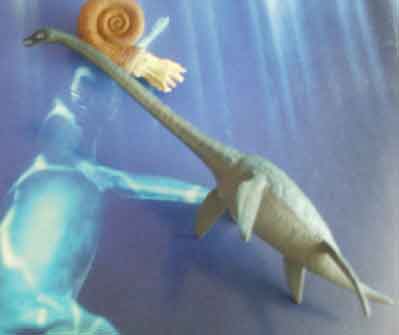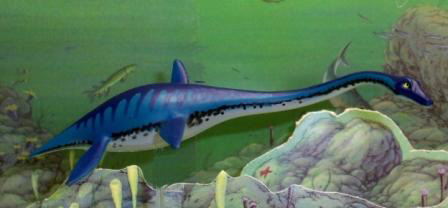The Late Cretaceous Sea
updated 110313
Elasmosaurid plesiosaurs were an important part of Cretaceous marine reptile communities and are generally considered to have been predators of small, agile, free-swimming fish and cephalopods. Professor Bob Bakker has speculated based on skull comparisons that the elasmosaurid plesiosaurs of the Cretaceous are not directly descended from the Jurassic plesiosaurs. Instead he has proposed that they re-evolved from the short-necked pliosaurs.
 Hydrotherosaurus ( "water beast lizard") is an elasmosaurid plesiosaur from the
Late Cretaceous. It is primarily
from a complete fossil found in California. Along with the creature's
last meal were gastroliths ("stomach stones"), which could have
helped anchor Hydrotherosaurus to the sea bottom,
where the food was. It had long pointed teeth, but these seem to have projected more to the sides rather than just up and down. This is a common feature seen in fish eating animals where the outward pointing teeth actually increase the available catch area for trapping prey. At up to thirteen meters in length, it was certainly one of the longest elasmosaurids.
Hydrotherosaurus ( "water beast lizard") is an elasmosaurid plesiosaur from the
Late Cretaceous. It is primarily
from a complete fossil found in California. Along with the creature's
last meal were gastroliths ("stomach stones"), which could have
helped anchor Hydrotherosaurus to the sea bottom,
where the food was. It had long pointed teeth, but these seem to have projected more to the sides rather than just up and down. This is a common feature seen in fish eating animals where the outward pointing teeth actually increase the available catch area for trapping prey. At up to thirteen meters in length, it was certainly one of the longest elasmosaurids.
 Futabasaurus
suzukii,a partial skeleton found in Japan expands the range
of elasmosaurid plesiosaurs. Santonian mudstone in the Tamayama Formation. The length was about 7 m, and the weight was about 3~4 tons.
Futabasaurus
suzukii,a partial skeleton found in Japan expands the range
of elasmosaurid plesiosaurs. Santonian mudstone in the Tamayama Formation. The length was about 7 m, and the weight was about 3~4 tons.
The long neck must have offered an advantage ambushing small faster prey, while limiting its speed and perhaps making it vulnerable to the newly evolving sharks and mosasaurs. The large size and extreme adaptations of the last plesiosaurs may be a sign they were under some kind of evolutionary stress. One idea is that plesiosaurs declined as modern types of sharks appear.
